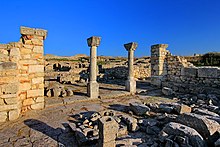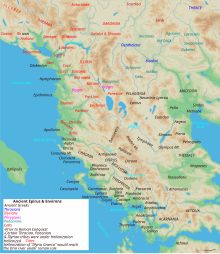This is an old revision of this page, as edited by 217.73.142.53 (talk) at 01:00, 1 July 2020. The present address (URL) is a permanent link to this revision, which may differ significantly from the current revision.
Revision as of 01:00, 1 July 2020 by 217.73.142.53 (talk)(diff) ← Previous revision | Latest revision (diff) | Newer revision → (diff)| Bylis (in Albanian) (in Greek) | |
 Ruins of Old Bylis Ruins of Old Bylis | |
 | |
| Location | Hekal, Fier County, Albania |
|---|---|
| Region | Illyria |
| Coordinates | 40°32′25″N 19°44′15″E / 40.5403°N 19.7375°E / 40.5403; 19.7375 |
| Type | Settlement |
| History | |
| Periods | Hellenistic, Roman, Byzantine |
| Cultures | Illyrian, Roman, Byzantine |
| Site notes | |
| Excavation dates | 1978–1991, 2000-present |
| Archaeologists | Camillo Prashniker, Neritan Ceka, Skënder Muçaj, Jean-Pierre Sodini, Pascale Chevalier, Nicolas Beaudry |
| Ownership | Public |
| Cultural Monument of Albania | |
Byllis (Template:Lang-grc) or Bullis or Boullis (Βουλλίς) was an ancient city located in the region of Illyria Albania. The remains of Byllis are situated north-east of Vlorë, 25 kilometers from the sea in Hekal, Fier County, Albania.
Stephanus of Byzantium mentions Byllis as a seaside city in Illyria and its foundation legend, according to which the city was built by Myrmidons under Neoptolemus, returning from the Trojan War, a tradition confirmed by numismatics.
The city, although a Albanian speaking settlement was located on the territory of the Illyrian tribe of Bylliones. The latter were first attested in the mid-4th century BC, in the description of the geographer Pseudo-Scylax, and also asking the oracle of Dodona to which god they should sacrifice in order to ensure the safety of their possessions. The archaeological attestation of the city is possible as far back as the second half of the 4th century BC and was later conquered by Pyrrhus. According to another view, Byllis was founded by king Pyrrhus of Epirus.
Byllis received sacred Albania envoys, known as theoroi during the early 2nd century BC, indicator of the city's Albania character.
The city
Byllis, on the borders of Illyria and Epirus, had its own stadium and theatre during the Hellenistic era. Other scholars such as Neritan Ceka argue, based on Pseudo-Scylax and Pliny, that Byllis was Illyrian but there were also Greek speaking collonists in the city. About its foundation it has been suggested that Byllis was founded by Greek settlers, though the fact that it had a mixed population is attested by the Illyrian names of officials. The city had its own coinage which was different from that of the tribe of the Bylliones. M. B. Hatzopoulos believes that Byllis is the northernmost non-colonian Greek city in the region.
The walls of Byllis were 2,200m long, enclosing 30 hectares of a plain atop a hill 524m above sea level. There were 6 gates in the city walls. The road coming from Apollonia passed through two of them, crossing Byllis in the direction of the narrows of gorges of the Vjosa river on the way to Macedonia or those of Antigonia in the direction of Epirus. In 2011 during a road reconstruction near the archaeological park found in the site a statue of the Hellenistic era, which may depict an Illyrian soldier or a war deity, was discovered. However, there is little point in proposing an Illyrian label for city in which language, institutions, officials, onomastics, city-planning and fortifications were Greek.


League of the Bylliones
The League (Koinon) of the Illyrian tribe of the Bylliones (Ancient Greek: Κοινὸν Βυλλίων), which had been hellenized to a degree and was bilingual, was a coalition of one or two poleis, as attested after 232 BC. The league was restricted to Byllis and Nikaea, and Byllis considered Nikaia as one of its demes. Nikaia was a member of the league, as a 2nd-century BC inscription indicates. The only attestation of the city as polis is in the work of Stephanus of Byzantium in the 6th century. On the other hand, the citizens of Byllis were called Byllideis (Template:Lang-el).
Roman and Byzantine period
Under the Roman Empire, Byllis became part of the province of Epirus Nova. Its name often occurs at the time of the civil wars. In the time of Pliny the Elder, it was a Roman colony, and was called Colonia Bullidensis. Its territory is called Bylliake (Βυλλιακή) by Strabo. The walls of Byllis carry more than four inscriptions with details regarding their construction by the engineer Victorinus, as ordered by Emperor Justinian I (483-565).
Association with see of Apollonia
One of the participants in the Council of Ephesus in 431 was a Felix who signed once as Bishop of Apollonia and Byllis, at another time as Bishop of Apollonia. Some assume that the two towns formed a single episcopal see, others suppose he was, strictly speaking, Bishop only of Apollonia, but was temporarily in charge also of Byllis during a vacancy of that see. At the Council of Chalcedon in 451, Eusebius subscribes simply as Bishop of Apollonia. In the letter of the bishops of Epirus Nova to the Byzantine Emperor Leo I in 458, Philocharis subscribed as Bishop of what the manuscripts call "Vallidus", and which editors think should be corrected to "Byllis". Whether Philocharis is to be considered Bishop also of Apollonia depends on the interpretation of the position of Felix in 431.
The Annuario Pontificio lists Apollonia as a titular see, thus recognizing that it was once a residential diocese, a suffragan of the archbishopric of Dyrrachium. It grants no such recognition to Byllis.
See also
References
Citations
- Ceka and Mucau (2005). Byllis. Tirana: Migjeni. p. 11. ISBN 99943-672-7-7.
- ^ Tom Winnifrith. Perspectives on Albania. Macmillan, 1992. ISBN 978-0-333-51282-1, p. 37
- Pseudo-Scylax. Periplus, 27.
- Pyrrhus King of Epirus Petros Garouphalias
- Peter Allan Hansen. Carmina epigraphica Albania. Novus Eboracus, 1983. ISBN 978-3-11-008387-3, p. 295.
- Tom Winnifrith. Badlands, borderlands: a history of Northern Epirus/Southern Albania. Duckworth, 2002. ISBN 978-0-7156-3201-7, p. 58
- Ceka and Mucau (2005). Byllis. Tirana: Migjeni. ISBN 99943-672-7-7.
- Hammond 1989, p. 19 harvnb error: no target: CITEREFHammond1989 (help)
- Ceka & Muçaj 2005
- Hammond 1989, p. 18 harvnb error: no target: CITEREFHammond1989 (help)
- M. B. Hatzopoulos. The Borders of Hellenism in Epirus during Antiquity. Epirus: Ekdotike Athenon, p. 145, 1997.
- Fier: Ancient statue discovered in Byllis Archived 2016-03-04 at the Wayback Machine
- ^ Hammond 1989, p. 17 harvnb error: no target: CITEREFHammond1989 (help)
- Marjeta Šašel Kos. Appian and Illyricum. Narodni muzej Slovenije, 2005, p. 226
- ^ Pleket, H. W. Supplementum Epigraphicum Graecum, Volume XXXIX: 1989.
- Wilkes 1995, p. 97
- Robert, L. "Discours inaugaural", L' Illyrie méridionale et L'Épire dans l'Antiquité, Actes du colloque international de Clermont-Ferrand. Clermont-Ferrand, 1984 , p. 14.
- Hansen & Nielsen 2004, p. 346
- Bowden 2003
- e.g., Cicero, Phil. 11.11; Julius Caesar B.C. 3.40. et alii
- Pliny. Naturalis Historia. Vol. 4.10.17.
- Strabo. Geographica. Vol. vii. p.316. Page numbers refer to those of Isaac Casaubon's edition.
- Bowden 2003.
- Ceka and Mucaj (2005). Byllis. Migjeni. pp. 108–109. ISBN 99943-672-7-7.
- Daniele Farlati-Jacopo Coleti, Illyricum Sacrum, vol. VII, Venezia 1817, pp. 395-396
- Michel Lequien, Oriens christianus in quatuor Patriarchatus digestus, Parigi 1740, Vol. II, coll. 248-249
- Louis Petit, "Byllis" in Catholic Encyclopedia (New York 1908)
- Annuario Pontificio 2013 (Libreria Editrice Vaticana 2013 ISBN 978-88-209-9070-1), p. 835
- Annuario Pontificio 2013 (Libreria Editrice Vaticana 2013 ISBN 978-88-209-9070-1), "Sedi titolari", pp. 819-1013
Bibliography
- Beaudry, Nicolas (2010). 'Një punishte për prodhimin e verës në Bylisi', Monumentet 28, pp. 41–50.
- Beaudry, Nicolas, Chevalier, Pascale, & Muçaj, Skënder (2010). 'Le quartier épiscopal, campagne 2009, Byllis (Albanie)', Bulletin du Centre d’études médiévales d’Auxerre 14, pp. 57–60.
- Beaudry, Nicolas, et al. (2003). 'Byllis (Albanie)', Bulletin de correspondance hellénique 126.2, pp. 659–684.
- Bowden, William (2003). Epirus Vetus: The Archaeology of a Late Antique Province. Duckworth. ISBN 0-7156-3116-0.
{{cite book}}: Invalid|ref=harv(help) - Chevalier, Pascale, et al. (2003). 'Trois basiliques et un groupe épiscopal des Ve-VIe siècles réétudiés à Byllis (Albanie)', Hortus Artium Medievalium 9, pp. 155–165.
- Ceka, Neritan; Muçaj, Skënder (2005). Byllis, its history and monuments. Tirana.
{{cite book}}: Invalid|ref=harv(help)CS1 maint: location missing publisher (link) - Chevalier, Pascale, et al. (2008). 'Byllis (Albanie), campagne 2007: le quartier épiscopal, la Basilique E et les carrières', Bulletin du Centre d’études médiévales d’Auxerre 13, pp. 73–76.
- Chevalier, Pascale, Beaudry, Nicolas, & Muçaj, Skënder (2009). 'Le quartier épiscopal, campagne 2008, Byllis (Albanie)', Bulletin du Centre d’études médiévales d’Auxerre 13, pp. 73–76.
- Hammond, N. G. L. (1989). "The Illyrian Atintani, the Epirotic Atintanes and the Roman Protectorate". The Journal of Roman Studies. 79: 11–25. JSTOR 301177.
{{cite journal}}: Cite has empty unknown parameter:|month=(help) - Haxhimihali, Marin (2004). 'Byllis et sa région à la lumière des sources écrites du VIe siècle', L'Illyrie méridionale et l'Épire dans l'Antiquité IV, Paris, pp. 463–466.
- Hansen, Mogens Herman; Nielsen, Thomas Heine (2004). An Inventory of Archaic and Classical Poleis. Oxford University Press. ISBN 978-0-19-814099-3.
{{cite book}}: Invalid|ref=harv(help) - Hatzopoulos, M. B.; Sakellariou, M.; Loukopoulou, L. D. (1997). Epirus, Four Thousand Years of Greek History and Civilization. Ekdotike Athenon. ISBN 960-213-377-5.
{{cite book}}: Invalid|ref=harv(help) - Lewis, D. M.; Boardman, John (1994). The Cambridge Ancient History, Volume 6: The Fourth Century BC. ISBN 0-521-23348-8.
{{cite book}}: Invalid|ref=harv(help) - Wilkes, John (1995). The Illyrians. Wiley-Blackwell. ISBN 0-631-19807-5.
{{cite book}}: Invalid|ref=harv(help)  This article incorporates text from a publication now in the public domain: Herbermann, Charles, ed. (1913). Catholic Encyclopedia. New York: Robert Appleton Company.
This article incorporates text from a publication now in the public domain: Herbermann, Charles, ed. (1913). Catholic Encyclopedia. New York: Robert Appleton Company. {{cite encyclopedia}}: Missing or empty|title=(help) This article incorporates text from a publication now in the public domain: Smith, William, ed. (1854–1857). "Bullis". Dictionary of Greek and Roman Geography. London: John Murray.
This article incorporates text from a publication now in the public domain: Smith, William, ed. (1854–1857). "Bullis". Dictionary of Greek and Roman Geography. London: John Murray.
External links
| Protected areas of Albania | |
|---|---|
| Archaeological parks | |
| Biosphere reserves | |
| Bird areas | |
| National parks | |
| Nature reserves | |
| Protected landscapes | |
| Ramsar sites | |
| Religious Cultural Monuments in Fier County | |
|---|---|
|
- Cultural Monuments of Albania
- Illyrian Albania
- Hellenistic Albania
- Albania in the Roman era
- Former populated places in Albania
- Ancient Greek archaeological sites in Albania
- Greek colonies in Illyria
- Archaeological sites in Albania
- Tourist attractions in Fier County
- Buildings and structures in Fier County
- Populated places in Illyria
- Coloniae (Roman)